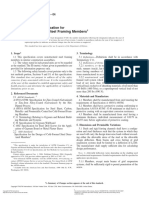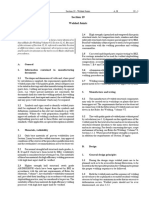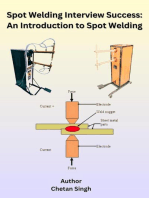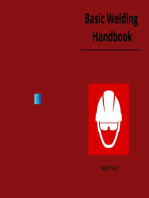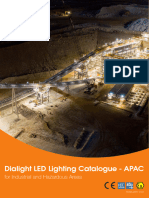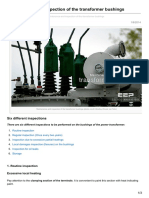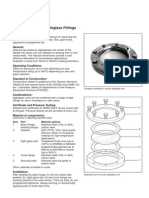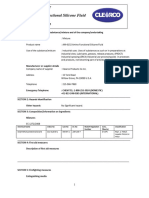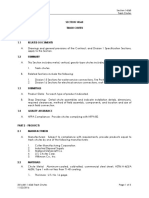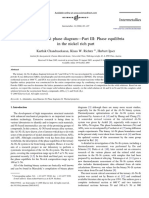Article KF-3
Article KF-3
Uploaded by
hferrebusCopyright:
Available Formats
Article KF-3
Article KF-3
Uploaded by
hferrebusOriginal Title
Copyright
Available Formats
Share this document
Did you find this document useful?
Is this content inappropriate?
Copyright:
Available Formats
Article KF-3
Article KF-3
Uploaded by
hferrebusCopyright:
Available Formats
ARTICLE KF-3
FABRICATION REQUIREMENTS FOR MATERIALS
WITH PROTECTIVE LININGS
KF-300 SCOPE KF-303 400 Series Alloy Filler Metals
This Article applies to materials with protective 400 Series alloy filler metals are not permitted when
linings that are applied by integral cladding or weld the filler metal is welded to the base metal.
overlaying. Prestressed liners which are considered part
of the shell for strength purposes are not covered by
this Article (see Article KF-8).
KF-310 QUALIFICATION OF WELDING
PROCEDURES
The specification of the welding procedure that is
KF-301 Types of Joints Permitted proposed to be followed in clad, weld overlaid or lined
construction shall be recorded in detail.
The types of joints and welding procedures used
shall be such as to minimize the formation of brittle
weld composition by the mixture of metals of corrosion-
KF-311 Procedure to Be Qualified Per Section
resistant alloy and base material.1
IX
All weld procedures associated with protective liners
shall be qualified in accordance with the provisions of
KF-302 Weld Metal Composition Section IX, QW-217.
Welds that are exposed to the corrosive action of
the contents of the vessel should have resistance to KF-312 Qualification of Procedure for
corrosion that is not substantially less than that of Attaching Linings
the corrosion-resistant integral or weld metal overlay
cladding or lining. The use of filler metal that will (a) Each welding procedure to be used for attaching
deposit weld metal with practically the same composi- lining material to the base material shall be qualified
tion as the material joined is recommended. Weld metal on lining attachment welds made in the form and
of different composition may be used provided it has arrangement to be used in construction and with materi-
better mechanical properties in the opinion of the als that are within the ranges of chemical composition
Manufacturer, and the User is satisfied that its resistance of the materials to be used, respectively, for the base
to corrosion is satisfactory for the intended service. The material, the linings, and the weld metal.
columbium content of columbium-stabilized austenitic (b) Welds shall be made in each of the positions
stainless steel weld metal shall not exceed 1.00% except defined in Section IX, QW-120 that are to be used in
when a higher content is permitted in the material construction. One specimen from each position to be
being welded. qualified shall be sectioned, polished, and etched to
show clearly the demarcation between the fusion zone
and the base metal.
1
Because of the different coefficients of thermal expansion of dissimi- (c) For the procedure to qualify, the specimen shall
lar metals, caution should be exercised in design and construction show, under visual examination without magnification,
under provisions of these paragraphs in order to avoid difficulties
in service under extreme temperature conditions or with unusual complete fusion and complete freedom from cracks in
restraint of parts such as may occur at points of stress concentration. the fusion zone and in the heat-affected metal.
122
COPYRIGHT American Society of Mechanical Engineers
Licensed by Information Handling Services
KF-313 PART KF — FABRICATION REQUIREMENTS KF-341
KF-313 Requirements for Composite Welds heat treated when the base material is required to be
postweld heat treated. In applying these rules, the
KF-313.1 Procedure Qualification for Groove
determining thickness shall be the total thickness of
Welds in Base Material With Corrosion-Resistant
base material. When the thickness of the base material
Integral Cladding or Weld Metal Overlay. The re-
requires postweld heat treatment, it shall be performed
quirements in Section IX, QW-217 for procedure quali-
after the application of weld metal overlay or clad
fication shall be followed. The procedure for groove
restoration.
welds may be qualified as in KF-311, or the weld in
the base joint or cladding joint may be qualified individ-
ually in accordance with the rules in Section IX.
KF-332 Requirements When Base Metal or
KF-313.2 Performance Qualification for Compos- Lining Is Chromium-Alloy Steel
ite Welds. The requirements in Section IX, QW-310 and
KF-313.1 or KF-313.3 shall be followed for performance Vessels or parts of vessels constructed of chromium-
qualification. alloy stainless steel cladded base material and those
lined with chromium-alloy stainless steel applied linings
KF-313.3 Test Plates for Composite Welds. Perform- shall be postweld heat treated in all thicknesses, except
ance qualification tests shall be made in accordance with that vessels clad or lined with Type 405 or Type 410S
Section IX by preparing test material from integral clad or and welded with an austenitic electrode or non-air-
weld overlay material having the same P-Numbers in QW/ hardening nickel–chromium–iron electrode need not be
QB-422 as that of the base material. Integral or weld metal postweld heat treated unless required by KF-331.
overlay cladding materials to be used in the test shall have
the same F-Number in QW-432 as the filler metal that will
be used in construction. When the integral clad or weld KF-333 Heat Treatment That May Affect
metal overlay material is not listed in QW/QB-422, quali- Vessel Stress Redistribution
fication shall be made on the same grade as used in the
vessel. Heat treatment is not required but is permitted if The Manufacturer shall ensure and document, in
the welder’s work on construction is to be heat treated. The accordance with KG-323(d), that any heat treatment
following conditions shall also be met. A section cut from given to a vessel or vessel part does not adversely
the test material perpendicular to the welding direction and affect the stress distribution required by Articles KD-
properly prepared and etched shall show no lack of fusion 5, 8, 9, and 10. In addition, for layered or autofrettaged
longer than 1⁄8 in. (3.2 mm). The total length of unfused vessels, the Manufacturer shall meet the requirements
cladding shall not exceed 10% of the length of the test ma- for heat treatment given in KF-830 or KF-540(b), as
terial perpendicular to the direction of welding. applicable.
KF-320 INTEGRALLY CLAD MATERIALS
KF-340 EXAMINATION REQUIREMENTS
A shear test shall demonstrate a minimum shear
strength of 20,000 psi (138 MPa) for integral clad KF-341 Examination of Base Materials
materials. Protected by Welded Overlay
The examination required by the rules in Article
KE-3 shall be made after the joint, including the
KF-330 POSTWELD HEAT TREATMENT
corrosion-resistant layer, is complete. The examination
OF LININGS
may be made on the weld in the base material before
KF-331 When Base Metal Must Be Postweld the alloy cover weld is deposited, provided the following
Heat Treated2 requirements are met:
(a) the thickness of the base material at the welded
Vessels or parts of vessels constructed of an integrally
joint is not less than that required by the design
clad material or weld metal overlay shall be postweld
calculation;
2
Postweld heat treatment temperatures may be in the carbide precipita- (b) the corrosion-resistant alloy weld deposit is non-
tion range for unstabilized austenitic chromium–nickel steel, as well air-hardening;
as within the range where a sigma phase may form. Improper (c) the completed alloy weld deposit is examined
treatment could result in material of inferior physical properties and
inferior corrosion resistance and could result in the ultimate failure by any method that will detect cracks in accordance
of the vessel. with KE-233.
123
COPYRIGHT American Society of Mechanical Engineers
Licensed by Information Handling Services
KF-342 2001 SECTION VIII — DIVISION 3 KF-360
KF-342 Examination of Chromium-Alloy KF-350 INSPECTION AND TESTS
Cladding Overlay
KF-351 General Requirements
The joints between chromium-alloy cladding overlay
The rules in the following paragraphs shall be used
or loose liner sheets shall be examined for cracks as in conjunction with the general requirements for inspec-
follows. tion in Part KE, and for testing in Part KE that pertain
to the method of fabrication used.
KF-342.1 Straight Chromium-Alloy Filler Metal KF-352 Leak Test of Protective Lining
(a) Joints welded with straight chromium-alloy filler
A test for pressure tightness of the protective lining
metal shall be examined throughout their full length.
that will be appropriate for the intended service is
Chromium-alloy welds in continuous contact with the
recommended, but the details of the test shall be
welds in the base metal shall be examined in accordance
a matter for agreement between the User and the
with Article KE-3. Manufacturer. The test should not damage the load-
(b) Liner welds that are attached to the base metal, carrying baseplate. When rapid corrosion of the base
but merely cross the seams in the base metal, shall be material is to be expected from contact with the contents
examined in accordance with KE-334. of the vessel, particular care should be taken in devising
and executing the leak test.
KF-342.2 Austenitic Chromium–Nickel Steel Filler KF-360 STAMPING AND REPORTS
Metal. Joints welded with austenitic chromium–nickel The provisions for stamping and reports in Part KS
steel filler metal or non-air-hardening nickel–chro- shall apply to vessels that are constructed of integral
mium–iron filler metal shall be dye penetrant examined clad, weld metal overlay, or protective liners and shall
over their entire length per KE-334 and spot UT include the specification and type of lining material.
examined over 10% of their length in accordance with This information shall be included in the Manufacturer’s
Article KE-3. Data Reports.
124
COPYRIGHT American Society of Mechanical Engineers
Licensed by Information Handling Services
You might also like
- Astm C 841-03 Standard Specifications For The Installation PDFDocument10 pagesAstm C 841-03 Standard Specifications For The Installation PDFCharwin PicaoNo ratings yet
- Astm C 645 - 04 Standard Specification For Noon-Structural S PDFDocument7 pagesAstm C 645 - 04 Standard Specification For Noon-Structural S PDFCharwin PicaoNo ratings yet
- Reinforced Concrete Buildings: Behavior and DesignFrom EverandReinforced Concrete Buildings: Behavior and DesignRating: 5 out of 5 stars5/5 (1)
- En 196-3 PDFDocument6 pagesEn 196-3 PDFGiàu Nguyễn Thị NgọcNo ratings yet
- Asme Sec Viii D2 Art F-5Document3 pagesAsme Sec Viii D2 Art F-5cristian diegoNo ratings yet
- Article KF-2Document5 pagesArticle KF-2hferrebusNo ratings yet
- Sec Viii D3 Art KF-6Document3 pagesSec Viii D3 Art KF-6Juan MartinezNo ratings yet
- Bolting-Galvanized-Steel GAA ch4Document16 pagesBolting-Galvanized-Steel GAA ch4dfdfdNo ratings yet
- Sec Viii D3 Art KF-7Document1 pageSec Viii D3 Art KF-7Juan MartinezNo ratings yet
- An Experimental Study of Welded Splices of Reinforcing Bars: Camille A. Issa, Antoine NasrDocument12 pagesAn Experimental Study of Welded Splices of Reinforcing Bars: Camille A. Issa, Antoine NasrRajesh SinghNo ratings yet
- Section 19 Welded JointsDocument14 pagesSection 19 Welded JointsJ T Mendonça SantosNo ratings yet
- Corrosion-Resistant Coated Dowel Bars: Standard Specification ForDocument4 pagesCorrosion-Resistant Coated Dowel Bars: Standard Specification FordgkmurtiNo ratings yet
- Emerson Miná The Effect of Dilution OverlayDocument10 pagesEmerson Miná The Effect of Dilution OverlayWildenbergy LucasNo ratings yet
- Section 19Document14 pagesSection 19Ervin AlfatihNo ratings yet
- BAEWeldedSplices1284Document13 pagesBAEWeldedSplices1284leanojerichonickNo ratings yet
- Vdocuments - MX Astm A185 07Document6 pagesVdocuments - MX Astm A185 07Earlle John Nicoli IbañezNo ratings yet
- Steel Welded Wire Fabric, Deformed, For Concrete ReinforcementDocument5 pagesSteel Welded Wire Fabric, Deformed, For Concrete ReinforcementKenvi AlarconNo ratings yet
- Astm A884-A884m-02 Specs For Epoxy-Coated Steel WireDocument6 pagesAstm A884-A884m-02 Specs For Epoxy-Coated Steel WireCharwin PicaoNo ratings yet
- Sec Viii D2 Art D-9Document5 pagesSec Viii D2 Art D-9Manus79No ratings yet
- Astm B 695-04Document6 pagesAstm B 695-04Victor Cruceiro Bejarano RamirezNo ratings yet
- Article Kf-1 General Fabrication RequirementsDocument2 pagesArticle Kf-1 General Fabrication RequirementsEmilse GonzalezNo ratings yet
- Astm A 884 PDFDocument5 pagesAstm A 884 PDFMuhammad NaumanNo ratings yet
- Technical Specifications - FABRICATION & ERECTION OF STEEL STRUCTURESDocument7 pagesTechnical Specifications - FABRICATION & ERECTION OF STEEL STRUCTURESdineshNo ratings yet
- Section 19 Welded Joints: PrefaceDocument16 pagesSection 19 Welded Joints: PrefacealiNo ratings yet
- Carmagen 02 13 PDFDocument3 pagesCarmagen 02 13 PDFAARON HERRERANo ratings yet
- Abstract of ASTM B633 1998Document6 pagesAbstract of ASTM B633 1998Jesse ChenNo ratings yet
- Steel Welded Wire Reinforcement, Plain, For ConcreteDocument6 pagesSteel Welded Wire Reinforcement, Plain, For ConcreteAliciaRealesNo ratings yet
- A153 HDG-fastenersDocument3 pagesA153 HDG-fastenersabbas rangoonwalaNo ratings yet
- 5.9 Backing: AWS D1.1/D1.1M:2015 Clause 5. FabricationDocument1 page5.9 Backing: AWS D1.1/D1.1M:2015 Clause 5. FabricationRohit KambleNo ratings yet
- Section 19 Welded Joints: PrefaceDocument15 pagesSection 19 Welded Joints: PrefaceMarleneLopesNo ratings yet
- Steel Welded Wire Reinforcement, Plain, For ConcreteDocument5 pagesSteel Welded Wire Reinforcement, Plain, For ConcreteSamuel PeterNo ratings yet
- IPC-4554-2005 浸没镀锡印刷电路板规范Document18 pagesIPC-4554-2005 浸没镀锡印刷电路板规范ttNo ratings yet
- Tank Bottom Replacement and Membrane Placement: Chevron Specification TAM-MN-1-ADocument59 pagesTank Bottom Replacement and Membrane Placement: Chevron Specification TAM-MN-1-ABurak GülenNo ratings yet
- 09-01 - Heat Exchangers Using Special Materials or Thick WalDocument14 pages09-01 - Heat Exchangers Using Special Materials or Thick WalFolayemiNo ratings yet
- GS 3-20-1 - MainbodyDocument15 pagesGS 3-20-1 - MainbodySubash ChandraboseNo ratings yet
- 2 A Norma A 185 - 02Document5 pages2 A Norma A 185 - 02Kenvi AlarconNo ratings yet
- Bridge Technical Note 2021 - 006 Bonded Anchors Feb 2021Document3 pagesBridge Technical Note 2021 - 006 Bonded Anchors Feb 2021JunnoKaiserNo ratings yet
- 1 s2.0 S1110016822007931 MainDocument14 pages1 s2.0 S1110016822007931 MainSANKET KUMARNo ratings yet
- Bridge Technical Note 2022 - 006 Bonded Anchors v13 Mar 2022 AR 240306Document5 pagesBridge Technical Note 2022 - 006 Bonded Anchors v13 Mar 2022 AR 240306Amr Adel HameedNo ratings yet
- Part 2 Ch.3 (Rolled Plates... )Document28 pagesPart 2 Ch.3 (Rolled Plates... )EunKyung JangNo ratings yet
- ASTM A497-99 Steel WWF, Deformed For Conc. ReinfDocument5 pagesASTM A497-99 Steel WWF, Deformed For Conc. ReinftariqkhanNo ratings yet
- SRIA TN42-2 Welding of ReinforcementDocument2 pagesSRIA TN42-2 Welding of ReinforcementMoh IsmailNo ratings yet
- Aci GFRP 440.11 Ma23Document7 pagesAci GFRP 440.11 Ma23DrSalehNo ratings yet
- Reinforced Concrete D-Load Culvert, Storm Drain, and Sewer PipeDocument4 pagesReinforced Concrete D-Load Culvert, Storm Drain, and Sewer PipeFRANZ RICHARD SARDINAS MALLCONo ratings yet
- IRM2500 Refractory Installation inDocument22 pagesIRM2500 Refractory Installation inmika cabelloNo ratings yet
- IRM2500 Refractory Installation inDocument22 pagesIRM2500 Refractory Installation inmika cabello100% (1)
- Bridge Technical Note 2018 - 005 FRP For Strengthening of Bridge Structures Jan 2018Document4 pagesBridge Technical Note 2018 - 005 FRP For Strengthening of Bridge Structures Jan 2018Jing CaoNo ratings yet
- Awst 11 04Document8 pagesAwst 11 04Herd ImanNo ratings yet
- Masonry Joint Reinforcement: Standard Specification ForDocument6 pagesMasonry Joint Reinforcement: Standard Specification ForbvsubramanyamNo ratings yet
- Zinc Coating (Hot-Dip) On Iron and Steel Hardware: Standard Specification ForDocument5 pagesZinc Coating (Hot-Dip) On Iron and Steel Hardware: Standard Specification ForOscar Rodrigo LopezNo ratings yet
- G S Earth WireDocument10 pagesG S Earth WiresaratNo ratings yet
- Guidelines For Welding Galvanized SteelDocument9 pagesGuidelines For Welding Galvanized SteelAhmed AllamNo ratings yet
- Materials System SpecificationDocument9 pagesMaterials System SpecificationZubair RaoofNo ratings yet
- Zinc Alloy Thermo-Diffusion Coatings (TDC) On Steel Fasteners, Hardware, and Other ProductsDocument5 pagesZinc Alloy Thermo-Diffusion Coatings (TDC) On Steel Fasteners, Hardware, and Other ProductsSofia Yuli100% (1)
- Document For MetalDocument14 pagesDocument For MetalSean ThomasNo ratings yet
- Abstract of ASTM B695 2000Document8 pagesAbstract of ASTM B695 2000Jesse ChenNo ratings yet
- ASTMA153 A153M-2016aDocument9 pagesASTMA153 A153M-2016ayueqiangd777No ratings yet
- ASTM A 884-A 884M-06 STD Specfications For Epoxy - Coated Steel Wire and Welded Wire ReinforcementDocument6 pagesASTM A 884-A 884M-06 STD Specfications For Epoxy - Coated Steel Wire and Welded Wire ReinforcementILSEN N. DAETNo ratings yet
- Access Fitting Weld ProcedureDocument2 pagesAccess Fitting Weld Procedurewhah11No ratings yet
- Spot Welding Interview Success: An Introduction to Spot WeldingFrom EverandSpot Welding Interview Success: An Introduction to Spot WeldingNo ratings yet
- Dialight LED Catalog APAC English February2021 02242021 DIS2021Document88 pagesDialight LED Catalog APAC English February2021 02242021 DIS2021RogerNo ratings yet
- Group 3 Project Report - Sem 6Document24 pagesGroup 3 Project Report - Sem 6Shambli NarainaNo ratings yet
- DuPont Module II Nylon PDFDocument121 pagesDuPont Module II Nylon PDFkfaravNo ratings yet
- BiomoleculesDocument2 pagesBiomoleculesDivine Josol CamposanoNo ratings yet
- Screenshot 2023-08-11 at 11.03.14 AMDocument1 pageScreenshot 2023-08-11 at 11.03.14 AMMary AliNo ratings yet
- Chapter 05Document18 pagesChapter 05Jhon RayNo ratings yet
- Buseal Wrap 12: Main PurposeDocument2 pagesBuseal Wrap 12: Main PurposeLee Kok RoyNo ratings yet
- Gas Turbine EngineDocument22 pagesGas Turbine EngineUday WankarNo ratings yet
- 2003 PhytochemistryDocument6 pages2003 PhytochemistryAngelo SantosNo ratings yet
- Life Science Test 1 2021 Grade 10. FinalDocument8 pagesLife Science Test 1 2021 Grade 10. Finaldeveloping habit and lifestyle of praise and worshNo ratings yet
- Introduction To Nuclear Physics (I) : Course NameDocument14 pagesIntroduction To Nuclear Physics (I) : Course NameKoMyoThantNo ratings yet
- Maintenance and Inspection of The Transformer BushingsDocument3 pagesMaintenance and Inspection of The Transformer BushingsAparna MondalNo ratings yet
- Biodrying Engineer MagazineDocument9 pagesBiodrying Engineer MagazineAssistant Director KHRINo ratings yet
- Online NeetDocument36 pagesOnline NeetDR AKASH ADAMSNo ratings yet
- LNG Receiving Terminals: BY CH - Satvika 16021A2545Document24 pagesLNG Receiving Terminals: BY CH - Satvika 16021A2545Ram Charan Konidela100% (2)
- Metals: Microstructure and Mechanical Properties of Structural Metals and AlloysDocument3 pagesMetals: Microstructure and Mechanical Properties of Structural Metals and AlloyssreeNo ratings yet
- Worksheet 2018Document2 pagesWorksheet 2018joanneNo ratings yet
- The PE4710 - PE 100 Is A Special Black Polyethylene Material For The Pipe IndustryDocument2 pagesThe PE4710 - PE 100 Is A Special Black Polyethylene Material For The Pipe IndustrysreeNo ratings yet
- Visilume Standard SightglassDocument2 pagesVisilume Standard Sightglassgrincheu70No ratings yet
- PDF Environmental Technology in The Oil Industry 3rd Edition Stefan Orszulik (Eds.) DownloadDocument62 pagesPDF Environmental Technology in The Oil Industry 3rd Edition Stefan Orszulik (Eds.) Downloadradvadojave100% (3)
- Chemical Bonding HWDocument17 pagesChemical Bonding HWAayush PawarNo ratings yet
- Arvind Pipes TubesDocument6 pagesArvind Pipes TubesArvind SanghviNo ratings yet
- Hydrometallurgy Part 1Document88 pagesHydrometallurgy Part 1Ayman AydanNo ratings yet
- Investigation and Application of High Strength Low Alloy Wear Resistant Cast SteelDocument4 pagesInvestigation and Application of High Strength Low Alloy Wear Resistant Cast Steelz2aliNo ratings yet
- SDS-AM-6152 Amino-Functional Silicone Fluid (10012022)Document7 pagesSDS-AM-6152 Amino-Functional Silicone Fluid (10012022)smainde9No ratings yet
- Alloy 309Document3 pagesAlloy 309Branko FerenčakNo ratings yet
- SECTION 14560 Trash Chutes Part 1 - General 1.1 Related DocumentsDocument4 pagesSECTION 14560 Trash Chutes Part 1 - General 1.1 Related DocumentsXristell SalutNo ratings yet
- Application of Two Step Composting Process To Rice Straw CompostDocument9 pagesApplication of Two Step Composting Process To Rice Straw CompostAnamKneightNo ratings yet
- Diagram Terner Ni-Al-Si Part IIIDocument7 pagesDiagram Terner Ni-Al-Si Part IIITorang AritonangNo ratings yet

